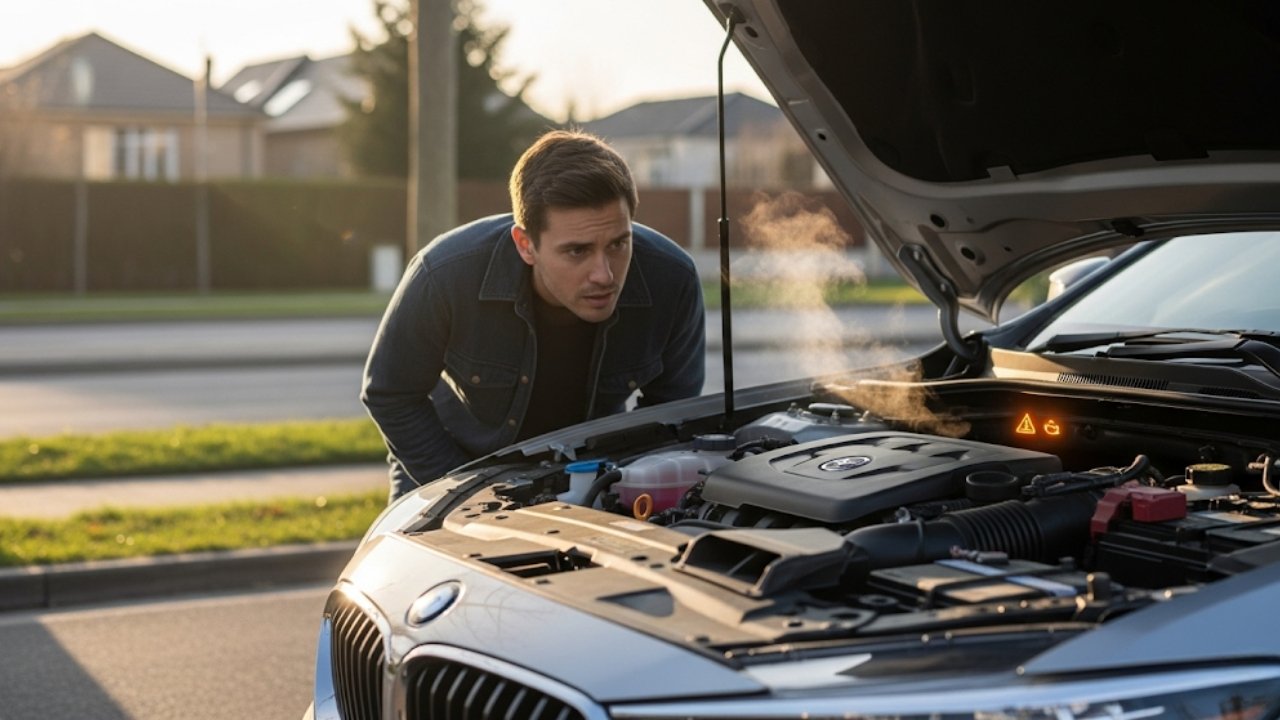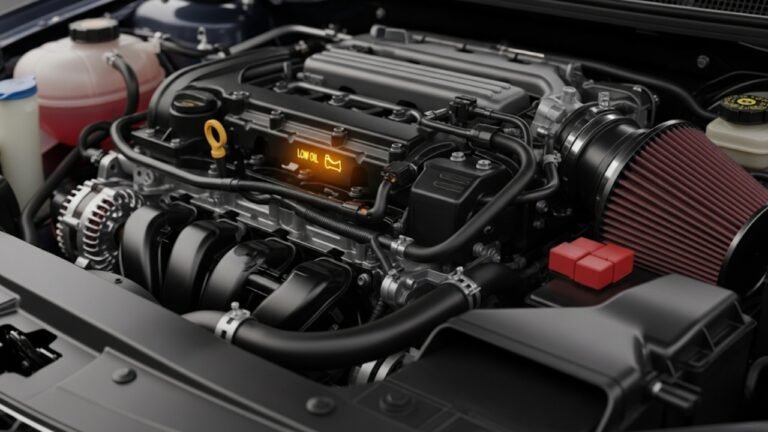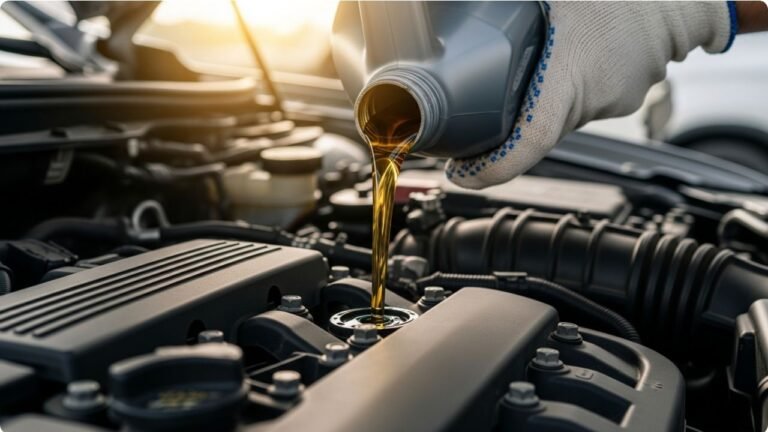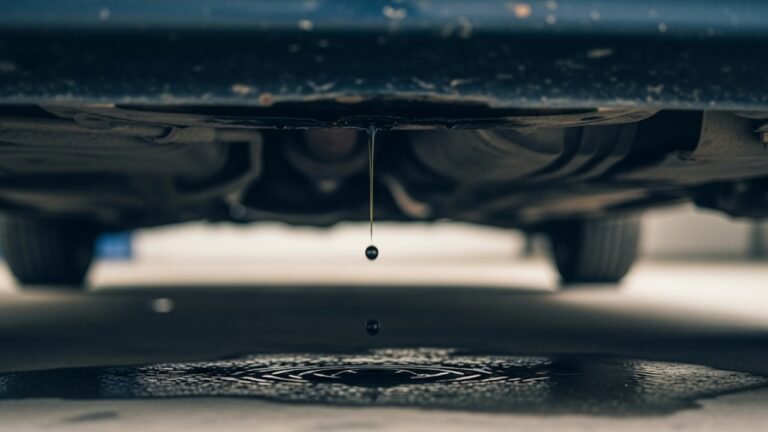Low Oil Pressure Car Won’t Start – Why It Happens and How to Fix It

It was a cold morning, and I had just stepped out, coffee in one hand, keys in the other. I turned the key in the ignition, expecting the usual hum of the engine. But—nothing. My car wouldn’t start. Panic hit me like a wave. Then, I saw the dashboard: that little red oil pressure warning light blinking. A sinking feeling grew in my gut. I later learned something every driver should know: low oil pressure can prevent your car from starting.
If you’ve found yourself scratching your head, wondering why your car is suddenly silent, and you’ve spotted warning lights or suspect an oil issue—you’re in the right place. This article will break it down in a way that’s easy to understand, like you’re talking to a friend who’s been through it all (because I have).
So let’s explore what it really means when a low oil pressure car won’t start, what causes it, and what you can do—without feeling overwhelmed or lost in car lingo.
What Is Oil Pressure and Why Does It Matter?

Here’s why it matters:
-
Oil reduces friction between engine parts
-
It helps disperse heat, preventing overheating
-
It keeps engine wear and tear to a minimum
-
It washes away dirt and debris
When the oil pressure is low, all of this is compromised. And modern cars are smart—they may refuse to start altogether to protect your engine from catastrophic damage.
Why a Low Oil Pressure Car Won’t Start – Key Causes
You might be surprised how many things can lead to low oil pressure. And yes, sometimes that’s exactly why your car won’t start.
Here are the most common causes:
-
Not enough oil in the engine
-
Oil pump failure
-
Blocked oil filter or oil passages
-
Worn-out bearings or components
-
Faulty oil pressure sensor
-
Cold weather thickening oil
-
Wrong type or old oil
Let’s break them down one by one.
1. Low Oil Level: The Silent Engine Killer
This one’s the most obvious—but it’s often ignored. If your car doesn’t have enough oil, there’s nothing for the pump to circulate. The oil pressure drops, and your engine senses the danger.
I once topped off my oil two months late and thought, “It’ll be fine.” Spoiler alert: it wasn’t. My car stalled, then refused to start until I added more oil.
✅ What to do: Check the dipstick. If the level’s low, top it off with the right type of oil. If it starts afterward, you’ve likely found the issue.
2. Oil Pump Failure – The Heart Stops Beating
The oil pump is like the heart of your engine—it keeps oil flowing. If it fails, there’s no pressure. No matter how much oil you have, it won’t circulate.
This is serious. Many vehicles have a built-in fail-safe that prevents startup when oil pressure is dangerously low—a lifesaver for your engine.
✅ What to do: You’ll need a mechanic. Diagnosing a faulty pump is tricky without lifting the engine apart.
3. Blocked Oil Passages or Filter – A Hidden Culprit
Ever try to drink a smoothie through a tiny straw? That’s what happens when sludge or debris clogs your oil passages or filter.
Even with a full tank of clean oil, a blockage prevents proper flow, leading to—you guessed it—low oil pressure.
✅ What to do: Try changing your oil and replacing the filter. If the car starts afterward, the clog may have been cleared.
4. Worn-Out Engine Bearings – The Long-Term Villain
Over time, your engine wears down. Bearings that used to fit tightly start to loosen. This lets oil flow too freely, which lowers pressure.
If your car has high mileage, this could be the root cause. Sadly, it’s not always a quick fix.
✅ What to do: Have a mechanic inspect your engine. This usually requires a rebuild or major repairs.
5. Faulty Oil Pressure Sensor – False Alarm?
Sometimes your car thinks it has low oil pressure—but it doesn’t. The oil pressure sensor, like any other part, can fail.
If this sensor gives off the wrong signal, your car’s computer might block the engine from starting.
✅ What to do: A diagnostic tool can check this easily. Replacing a sensor is cheap and fast.
6. Cold Weather: Thick Oil Means Trouble
In colder climates, oil becomes thicker and harder to pump. This makes it harder to build pressure, especially if you’re using the wrong viscosity.
✅ What to do: Use winter-grade oil. Let your car warm up for a few minutes before trying to start.
7. Using the Wrong Oil – A Small Mistake With Big Results
It may seem harmless, but using oil that’s too thick or too thin can mess with oil pressure. Every car has its own oil spec, and ignoring it can lead to startup issues.
✅ What to do: Always check your manual and use the recommended oil. If you’re unsure, go with a trusted mechanic’s advice.
How to Tell if Low Oil Pressure Is the Reason Your Car Won’t Start
Not sure if low oil pressure is the real issue? Look out for these tell-tale signs:
-
Oil pressure warning light (a red oil can symbol)
-
Clicking or ticking noise when turning the key
-
Engine cranks but won’t start
-
Recent oil change issues (wrong oil, clogged filter)
-
Long gap since last oil check or top-up
Here’s a quick reference table:
| Symptom | Possible Cause | What to Do |
|---|---|---|
| Oil light on dashboard | Low oil or bad sensor | Check dipstick and sensor |
| Engine won’t crank at all | Severe engine lock or protection mode | Tow to a mechanic |
| Cranking but no start | Oil not circulating | Check filter, pump, oil level |
| No noise at all | Electrical or oil pressure lock | Scan ECU for codes |
Can a Car Really Refuse to Start Due to Low Oil Pressure? Yes, And Here’s Why
Here’s the deal—modern cars are designed to protect themselves. When your vehicle detects dangerously low oil pressure, it may prevent the engine from starting at all. This isn’t a flaw—it’s a safety feature.
Why? Because running your engine without oil pressure is like running a marathon without any water. It leads to overheating, metal-on-metal friction, and eventually, engine seizure.
And trust me, you don’t want to deal with that repair bill.
How I Fixed My “Low Oil Pressure Car Won’t Start” Problem
Here’s a real story. A few years back, I ignored an oil light thinking it was just a glitch. I was low on cash and figured I’d stretch it till next payday.
Then one morning, my car just… didn’t start. Panic. Regret. I topped up the oil—but still nothing. Turned out my oil filter was clogged, and the engine went into safe mode.
After a quick oil change and a filter swap, it came back to life like a charm. Lesson learned: Never ignore the red oil light. It’s not a suggestion—it’s a scream.
How to Prevent This Issue From Happening Again
You don’t want to be late for work or stranded in a parking lot, wondering why your low oil pressure car won’t start. Here’s how to stay ahead of the problem:
-
Check your oil level once a month
-
Get regular oil changes (every 3,000–5,000 miles or as per your car’s manual)
-
Use the correct oil type and viscosity
-
Listen for odd engine sounds
-
Replace your oil filter during oil changes
-
Pay attention to dashboard warning lights
How to Fix a Low Oil Pressure Issue That’s Preventing Your Car from Starting
Now that we know why a low oil pressure car won’t start, let’s get hands-on and figure out how to fix it. You don’t need to be a mechanic to understand these steps—but depending on the issue, you may need one to help.
Let’s go step by step.
✅ Step 1: Check the Oil Level
This is the easiest fix—and often the most overlooked.
-
Pop the hood
-
Pull out the dipstick, wipe it clean, reinsert it, then check again
-
If the oil is below the low mark, top it off with the correct grade
Important: Don’t just pour in random oil. Use what your car manual recommends (e.g., 5W-30, 10W-40).
If your car starts after adding oil, it likely went into protection mode due to low oil.
✅ Step 2: Replace the Oil Filter
If your filter is clogged, it can prevent proper oil flow and kill pressure. Here’s how to change it:
-
Drain the old oil
-
Unscrew the old filter (use a filter wrench)
-
Rub a bit of new oil on the rubber gasket of the new filter
-
Screw it in and refill with clean oil
Filters are cheap (usually under $15), and changing one takes 10 minutes if you have the tools.
✅ Step 3: Test or Replace the Oil Pressure Sensor
If you’ve got oil and the filter is new, the issue might be electrical.
A bad oil pressure sensor might falsely tell your ECU (engine control unit) that the pressure is too low. That may cause your car to refuse to start.
A mechanic can:
-
Use an OBD-II scanner to check codes
-
Replace the sensor if needed (usually a $30–$100 part)
✅ Step 4: Inspect the Oil Pump
This part isn’t for beginners. If the pump fails, oil simply can’t circulate. It’s usually buried deep inside the engine and needs professional inspection.
Signs your oil pump might be dead:
-
No oil pressure even after topping off oil
-
Ticking or knocking noises from the engine
-
Your engine suddenly shuts down after starting
If confirmed, expect to pay $400–$1,000 to replace it, depending on labor and car model.
✅ Step 5: Look for Leaks or Burning Oil
Sometimes you think you have enough oil—but you’re losing it quietly.
Check for:
-
Oil puddles under your car
-
Burning smell or blue smoke from the exhaust
-
Sticky oil residue around the valve cover or oil pan
If you find a leak, fix it immediately. Letting it go for too long can wear down internal parts and reduce oil pressure.
When Should You Call a Mechanic?
DIY is great, but sometimes you’ve got to call in the pros. Here’s when you should:
-
You’ve topped up oil and replaced the filter, but still no start
-
You hear strange noises from the engine
-
The engine cranks weakly or not at all
-
The oil pressure light stays on even after filling the oil
-
You suspect internal damage (like worn bearings)
Good mechanics will run a full diagnostic scan, check oil pressure with a mechanical gauge, and spot problems you can’t see.
What Happens If You Ignore Low Oil Pressure and Keep Trying to Start?
Let me be real: ignoring low oil pressure can kill your engine.
Every time you crank the engine without oil pressure, you’re dry-starting it. That means the metal parts inside the engine are rubbing together without protection. It’s like running a chainsaw with no lubrication—pure destruction.
Here’s what could happen:
-
Scored cylinders
-
Worn camshaft or crankshaft
-
Total engine failure
And replacing an engine? Easily $3,000 to $7,000. So, if you see the signs, stop cranking and figure out the cause first.
Is It Always an Oil Pressure Issue? Other Possible Causes for No Start
While this guide focuses on oil pressure, it’s fair to consider other common reasons your car might not start:
| Symptom | Other Possible Cause |
|---|---|
| No crank, no click | Dead battery or ignition issue |
| Cranks but sputters | Fuel system problems |
| Cranks normally but no fire | Spark plug or coil issue |
| Clicking only | Bad starter motor or solenoid |
| No dashboard lights | Blown fuse or battery cable issue |
Still, if that oil light is on, always deal with that first.
FAQs – Low Oil Pressure Car Won’t Start
❓Can low oil pressure cause a car not to start?
Yes. Most modern vehicles are programmed to prevent engine start when oil pressure is dangerously low. It’s a protective feature to prevent engine damage.
❓How do I know if my oil pump has failed?
Look for signs like:
-
Oil light stays on after filling oil
-
Loud ticking or knocking sounds
-
Engine shuts off shortly after starting
Only a mechanical gauge or teardown can confirm it. A mechanic is your best bet here.
❓Can a bad oil pressure sensor stop a car from starting?
Yes, sometimes. If your car’s computer relies on sensor input to allow ignition, a failed sensor might block startup—even when pressure is actually fine.
❓What oil should I use to avoid low pressure?
Always use what your owner’s manual suggests. In cold climates, go for thinner oils like 5W-30. In hotter areas, 10W-40 may be better.
❓How much does it cost to fix low oil pressure?
It depends on the cause:
-
Oil top-up: $10–$30
-
New oil filter: $10–$20
-
Oil pressure sensor: $30–$100
-
Oil pump replacement: $400–$1,000
-
Engine rebuild: $2,500–$7,000
❓How long can an engine run with low oil pressure?
Not long at all. In most cases, running with low oil pressure for more than a few minutes can cause permanent engine damage.
❓Why does my car crank but not start after an oil change?
If your car won’t start after an oil change, it could be due to:
-
Wrong oil type
-
Overfilling or underfilling
-
Disconnected sensor
-
Air pockets in oil system
Check everything carefully and consult your manual.
❓Can weather affect oil pressure?
Absolutely. Cold temperatures make oil thicker, which slows circulation and reduces pressure—especially if you use the wrong oil for winter.
Final Thoughts: Don’t Let Oil Pressure Kill Your Ride
It’s crazy how one tiny thing—like a clogged filter or low oil level—can stop your whole car in its tracks. I’ve been there, and I know the stress that comes with a low oil pressure car won’t start moment.
But here’s the good news: most of these problems are preventable with a little maintenance and awareness.






